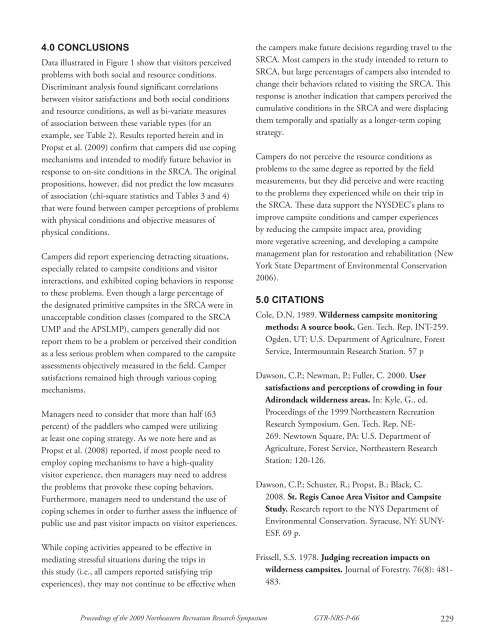Proceedings of the 2009 northeastern recreation research symposium
Proceedings of the 2009 northeastern recreation research symposium
Proceedings of the 2009 northeastern recreation research symposium
You also want an ePaper? Increase the reach of your titles
YUMPU automatically turns print PDFs into web optimized ePapers that Google loves.
4.0 CONCLUSIONS<br />
Data illustrated in Figure 1 show that visitors perceived<br />
problems with both social and resource conditions.<br />
Discriminant analysis found signifi cant correlations<br />
between visitor satisfactions and both social conditions<br />
and resource conditions, as well as bi-variate measures<br />
<strong>of</strong> association between <strong>the</strong>se variable types (for an<br />
example, see Table 2). Results reported herein and in<br />
Propst et al. (<strong>2009</strong>) confi rm that campers did use coping<br />
mechanisms and intended to modify future behavior in<br />
response to on-site conditions in <strong>the</strong> SRCA. Th e original<br />
propositions, however, did not predict <strong>the</strong> low measures<br />
<strong>of</strong> association (chi-square statistics and Tables 3 and 4)<br />
that were found between camper perceptions <strong>of</strong> problems<br />
with physical conditions and objective measures <strong>of</strong><br />
physical conditions.<br />
Campers did report experiencing detracting situations,<br />
especially related to campsite conditions and visitor<br />
interactions, and exhibited coping behaviors in response<br />
to <strong>the</strong>se problems. Even though a large percentage <strong>of</strong><br />
<strong>the</strong> designated primitive campsites in <strong>the</strong> SRCA were in<br />
unacceptable condition classes (compared to <strong>the</strong> SRCA<br />
UMP and <strong>the</strong> APSLMP), campers generally did not<br />
report <strong>the</strong>m to be a problem or perceived <strong>the</strong>ir condition<br />
as a less serious problem when compared to <strong>the</strong> campsite<br />
assessments objectively measured in <strong>the</strong> fi eld. Camper<br />
satisfactions remained high through various coping<br />
mechanisms.<br />
Managers need to consider that more than half (63<br />
percent) <strong>of</strong> <strong>the</strong> paddlers who camped were utilizing<br />
at least one coping strategy. As we note here and as<br />
Propst et al. (2008) reported, if most people need to<br />
employ coping mechanisms to have a high-quality<br />
visitor experience, <strong>the</strong>n managers may need to address<br />
<strong>the</strong> problems that provoke <strong>the</strong>se coping behaviors.<br />
Fur<strong>the</strong>rmore, managers need to understand <strong>the</strong> use <strong>of</strong><br />
coping schemes in order to fur<strong>the</strong>r assess <strong>the</strong> infl uence <strong>of</strong><br />
public use and past visitor impacts on visitor experiences.<br />
While coping activities appeared to be eff ective in<br />
mediating stressful situations during <strong>the</strong> trips in<br />
this study (i.e., all campers reported satisfying trip<br />
experiences), <strong>the</strong>y may not continue to be eff ective when<br />
<strong>the</strong> campers make future decisions regarding travel to <strong>the</strong><br />
SRCA. Most campers in <strong>the</strong> study intended to return to<br />
SRCA, but large percentages <strong>of</strong> campers also intended to<br />
change <strong>the</strong>ir behaviors related to visiting <strong>the</strong> SRCA. Th is<br />
response is ano<strong>the</strong>r indication that campers perceived <strong>the</strong><br />
cumulative conditions in <strong>the</strong> SRCA and were displacing<br />
<strong>the</strong>m temporally and spatially as a longer-term coping<br />
strategy.<br />
Campers do not perceive <strong>the</strong> resource conditions as<br />
problems to <strong>the</strong> same degree as reported by <strong>the</strong> fi eld<br />
measurements, but <strong>the</strong>y did perceive and were reacting<br />
to <strong>the</strong> problems <strong>the</strong>y experienced while on <strong>the</strong>ir trip in<br />
<strong>the</strong> SRCA. Th ese data support <strong>the</strong> NYSDEC’s plans to<br />
improve campsite conditions and camper experiences<br />
by reducing <strong>the</strong> campsite impact area, providing<br />
more vegetative screening, and developing a campsite<br />
management plan for restoration and rehabilitation (New<br />
York State Department <strong>of</strong> Environmental Conservation<br />
2006).<br />
5.0 CITATIONS<br />
Cole, D.N. 1989. Wilderness campsite monitoring<br />
methods: A source book. Gen. Tech. Rep. INT-259.<br />
Ogden, UT: U.S. Department <strong>of</strong> Agriculture, Forest<br />
Service, Intermountain Research Station. 57 p<br />
Dawson, C.P.; Newman, P.; Fuller, C. 2000. User<br />
satisfactions and perceptions <strong>of</strong> crowding in four<br />
Adirondack wilderness areas. In: Kyle, G., ed.<br />
<strong>Proceedings</strong> <strong>of</strong> <strong>the</strong> 1999 Nor<strong>the</strong>astern Recreation<br />
Research Symposium. Gen. Tech. Rep. NE-<br />
269. Newtown Square, PA: U.S. Department <strong>of</strong><br />
Agriculture, Forest Service, Nor<strong>the</strong>astern Research<br />
Station: 120-126.<br />
Dawson, C.P.; Schuster, R.; Propst, B.; Black, C.<br />
2008. St. Regis Canoe Area Visitor and Campsite<br />
Study. Research report to <strong>the</strong> NYS Department <strong>of</strong><br />
Environmental Conservation. Syracuse, NY: SUNY-<br />
ESF. 69 p.<br />
Frissell, S.S. 1978. Judging <strong>recreation</strong> impacts on<br />
wilderness campsites. Journal <strong>of</strong> Forestry. 76(8): 481-<br />
483.<br />
<strong>Proceedings</strong> <strong>of</strong> <strong>the</strong> <strong>2009</strong> Nor<strong>the</strong>astern Recreation Research Symposium GTR-NRS-P-66<br />
229
















